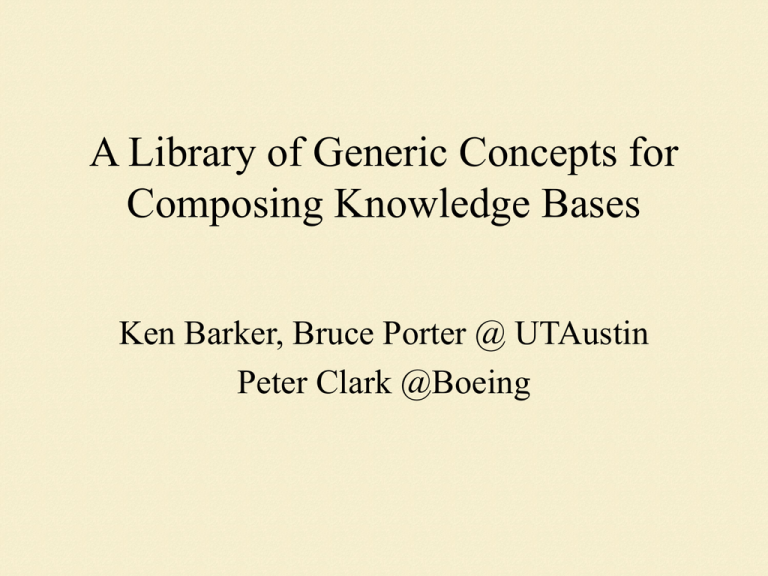A Library of Generic Concepts for Composing Knowledge Bases Peter Clark @Boeing
advertisement

A Library of Generic Concepts for Composing Knowledge Bases Ken Barker, Bruce Porter @ UTAustin Peter Clark @Boeing “Normal people don’t have the skills or the time to build knowledge bases” -- anonymous knowledge engineer c. last week Our Goal • to get domain experts build knowledge bases in their area of expertise directly – build a KB without writing axioms – build a KB through the instantiation and composition of existing knowledge building blocks Our Project • even domain-specific representations contain repeated abstractions • so build a library consisting of – a small hierarchy of reusable, composable, domain-independent knowledge units (“components”) – a small vocabulary of relations to connect them A Library of Components • • • • easy to learn easy to use broad semantic distinctions (easy to choose) allows detailed pre-engineering Outline 1. 2. 3. 4. Library requirements Library construction/contents Composition Evaluation Requirements • coverage – • access – • what are some domain-independent concepts? how can SMEs find the components they need (and buy into them)? semantics – – – what knowledge is encoded in components? how are components composed? what additional knowledge is inferred through their composition? 1. 2. 3. 4. Library requirements Library construction/contents Composition Evaluation Coverage • small number of components covering a wide range of generic concepts – – – – general enough that the small number is sufficiently broad specific enough that users are willing to make the abstraction from a domain concept to a component intuitive/usable… yes! elegant, philosophically appealing, computationally friendly… ehnh :-7 1. Library requirements 2. 3. 4. • coverage • access • semantics Library construction/contents Composition Evaluation Access • • browsing the hierarchy top-down WordNet-based search – – – • all components have hooks to WordNet climb the WordNet hypernym tree with search terms assemble: Attach, Come-Together mend: Repair infiltrate: Enter, Traverse, Penetrate, Move-Into gum-up: Block, Obstruct busted: Be-Broken, Be-Ruined documentation 1. 2. 3. 4. Library requirements • coverage • access • semantics Library construction/contents Composition Evaluation Semantics • • • axiomatize the concepts axiomatize the relations specify the behavior of composition – additional inferencing possible from the composition beyond the semantics of the components/relations 1. 2. 3. 4. Library requirements • coverage • access • semantics Library construction/contents Composition Evaluation Library Construction • draw from related work – – ontology design/knowledge engineering linguistics • • • semantic primitives case theory, discourse analysis, NP semantics draw from English lexical resources – – dictionaries, thesauri, word lists WordNet, Roget, LDOCE, corpora, etc. 1. 2. 3. 4. Library requirements Library construction/contents Composition Evaluation Library Contents • actions — things that happen, change states – • states — relatively temporally stable events – • Be-Closed, Be-Attached-To, Be-Confined, etc. entities — things that are – • Enter, Copy, Replace, Transfer, etc. Substance, Place, Object, etc. roles — things that are, but only in the context of things that happen – Container, Catalyst, Template, Vehicle, etc. 1. 2. 3. 4. Library requirements Library construction/contents Composition Evaluation Library Contents • relations between events, entities, roles – – – – • agent, donor, object, recipient, result, etc. content, part, material, possession, etc. causes, defeats, enables, prevents, etc. purpose, plays, etc. properties between events/entities and values – – rate, frequency, intensity, direction, etc. size, color, integrity, shape, etc. 1. 2. 3. 4. Library requirements Library construction/contents Composition Evaluation Composition • semantics of Entities, Events and Roles + semantics of relations allow for new inferences through composition – – – context-dependent rules “definitions” simulation with STRIPS-like operators 1. 2. 3. 4. Library requirements Library construction/contents Composition Evaluation Composition • MRNA-Transport – “MRNA is transported out of the cell nucleus into the cytoplasm” 1. 2. 3. 4. Library requirements Library construction/contents Composition Evaluation location Evaluation • Can DomEs learn to use the library to encode domain knowledge? • Can sophisticated knowledge be captured through composition of components? 1. 2. 3. 4. Library requirements Library construction/contents Composition Evaluation Evaluation • train Biologists for two weeks • have the Biologists encode knowledge from a college-level Biology textbook using our tools • supply end-of-the-chapter-style Biology questions • have the Biologists pose the questions to their knowledge bases and record the answers • evaluate the answers on a scale of 0-3 • qualitatively evaluate their KBs 1. 2. 3. 4. Library requirements Library construction/contents Composition Evaluation Evaluation — Productivity Axioms × 1000 2.5 2.0 1.5 Structural Implication Total 1.0 0.5 0.0 6/25 7/2 7/9 7/16 7/23 7/30 1. 2. 3. 4. Library requirements Library construction/contents Composition Evaluation Evaluation — Question Answering wrong 16% right 54% poor 15% pretty good 15% 1. 2. 3. 4. Library requirements Library construction/contents Composition Evaluation Evaluation — Anecdotal “A list of perhaps ~50-100 [relations] would cover 95% of the assertions needed to describe any process in cell/molecular biology.” “Cognitive Transparency … the Movement model in KM’s component library.” “It changed the way I think about Biology.” 1. 2. 3. 4. Library requirements Library construction/contents Composition Evaluation What’s Next? • it’s easy, but is it sufficient? • more components – roles, property values, compound actions • more semantics – richer process language, default knowledge, more context • more domains Questions 1. 2. 3. 4. 5. Why do you think this is the “right” way? Surely you don’t believe you’ve found The Primitives. You haven’t shown that your library is useful for anything except the one task that is the context under which it was developed. You admit that the library is not complete. How will you know when it is? Axiom counting is meaningless. I need to see compelling quantitative evaluation.







